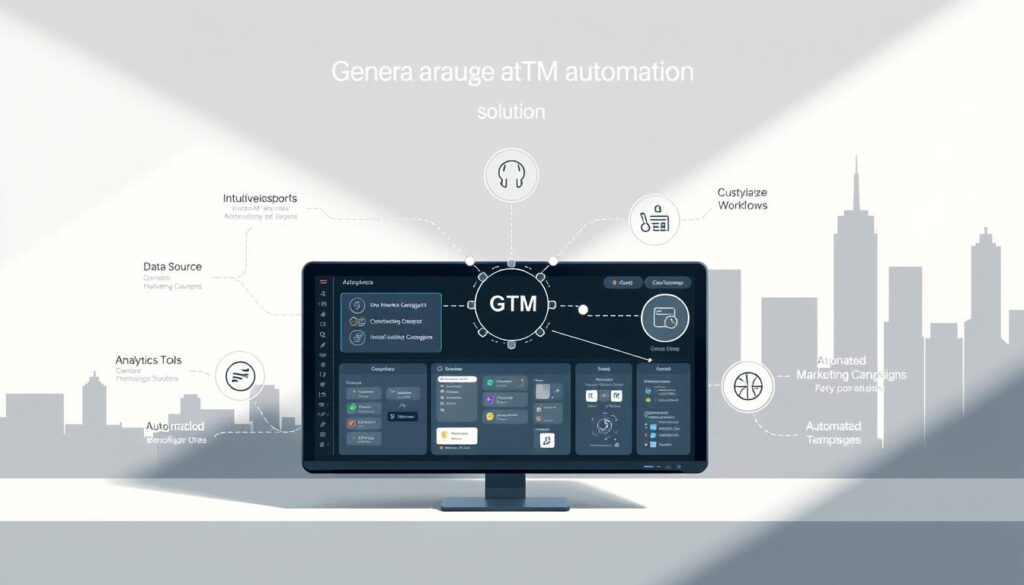In the fast-changing market today, companies must innovate to stay ahead. Ensuring scalability and flexibility with GTM automation is key. Companies should blend their growth with evolving customer needs. These needs are shifting towards personalized and smooth experiences. A recent study shows 80% of organizations put customer experience first. This shows old GTM methods aren’t enough.
Businesses must use GTM automation strategies to stay competitive. This lets them improve processes and boost customer interaction. GTM automation helps teams quickly adjust to market changes, making sure they satisfy customer needs. We’ll dive deep into GTM automation in this article, highlighting its benefits and best practices for continuous business growth.
Key Takeaways
- GTM automation is critical for adapting to fast-changing market conditions.
- Personalized customer experiences drive the need for scalable solutions.
- Effective GTM automation strategies enhance overall business efficiency.
- Organizations aiming for growth must consider automation in their GTM frameworks.
- Regular optimization of automation processes is vital for sustained success.
Understanding GTM Automation and Its Benefits
In this quick-moving business world, GTM automation has become important for companies wanting smoother operations. It covers different tools that make launching products or services more efficient. By using smart analytics and software, companies reduce manual work and get valuable data insights in real-time.
The use of GTM automation leads to better decision-making, more engagement, and higher conversion rates. It makes operations smarter, helping businesses to grow faster.
What is GTM Automation?
GTM automation means using tech to make go-to-market strategies better and more automatic. It includes gtm automation tools that help marketing, sales, and customer service teams work better together. This approach helps businesses communicate in more useful ways.
With these tools, companies can change old ways of working. They become more proactive in how they talk to the market.
Key Advantages of Implementing GTM Automation
Using GTM automation has many benefits that positively affect a company’s success. Important gtm automation benefits include:
- Enhanced Operational Efficiency: Automation lets organizations do repetitive tasks quicker, freeing up time for bigger projects.
- Increased Accuracy: It lowers the chance of human mistakes, making sure services are always top-notch.
- Real-Time Data Insights: These systems analyze data fast, helping to make quick, informed decisions that match market trends.
- Scalability: With gtm automation implementation, businesses can expand without needing lots more resources, which is key for growth.

Adopting GTM automation solutions helps companies succeed in a tough market. Applying these technologies well leads to big improvements in performance and presence in the market.
Assessing Scalability in GTM Automation
Understanding how GTM automation scales is key to evaluating its performance and capacity. Companies can examine different metrics to see if their systems can handle more work. They can find out what works best and make their GTM automation better.
Key Metrics for Scalability
To figure out scalability, certain metrics are used to gauge success. Key indicators include:
- Lead Conversion Rates: This shows how well marketing turns into sales.
- Customer Engagement Levels: Knowing this helps customize services and messages for customers.
- Speed of Outreach: Being quick to reach potential customers is crucial.
- Response Times: Good automation keeps up with more work without slowing down in responding to customers.
Using tools to track data gives a full view of how automation is doing. These key metrics help follow best practices for scaling up GTM automation. It helps companies grow their automation the right way.
Identifying Scalability Challenges
Even though GTM automation offers growth chances, there can be challenges. These problems include:
- Siloed Data: Scattered systems create gaps in information, making it hard to make quick decisions.
- Integration Difficulties: It can be tough to mix different marketing tools smoothly.
- Complexity in Personalization: It gets harder to keep things personal with customers as a business grows.
It’s important to recognize these issues early on. This way, a business can improve its GTM automation strategy. Overcoming these obstacles ensures that efforts to scale up GTM automation lead to lasting growth.

Achieving Flexibility through GTM Automation
Flexibility is key in successful GTM automation. It lets businesses quickly adapt to a changing market. By using robust customization in GTM strategy, companies can make a big impact. Automation offers ways to improve workflows, which helps personalize customer interactions. This personal touch makes marketing messages hit home with audiences.
Customization Options in GTM Automation
Automation tools help businesses target their audiences better. This allows for messages that really speak to people’s needs. To make GTM automation work best, it’s important to keep tweaking strategies. This helps draw more interest and increase sales. For example, using content that changes with customer actions keeps things relevant and engaging. This approach strengthens customer bonds.
Real-Time Adaptability
Being able to adapt quickly is crucial for GTM automation. It lets organizations respond fast to feedback or market shifts. Adding automation to marketing and sales means businesses can change tactics quickly. They can use data to spot trends and problems early on. This quick thinking helps businesses stay flexible and grow, even as things change.
Innovative strategies help companies stay ahead and keep people engaged. Choosing the right gtm automation solutions leads to great flexibility and quick responses. This is vital for success in our fast-paced world.
Best Practices for Leveraging GTM Automation
For any organization looking to improve, implementing gtm automation effectively is key. It’s crucial to mesh GTM with current systems for seamless operations. This removes barriers and lets organizations fully use gtm automation’s capabilities.
Integrating GTM with Existing Systems
Starting with integration is where successful gtm automation begins. It’s about making sure all tech aspects cooperate for smooth data flow. This boosts efficiency and betters overall results. Going modular helps teams start small and grow their automation in line with their needs.
Regular Monitoring and Optimization
Keeping gtm automation useful means constantly checking and tweaking it. Comparing results to key goals helps identify where to improve. Using predictive analytics and watching user trends helps make smart changes. Setting up feedback loops keeps strategies in line with goals and market changes. For more on boosting efficiency,check out this link.
Future Trends in GTM Automation
The landscape of GTM automation is about to change in big ways, thanks to new tech. Emerging technologies are changing how companies handle marketing and sales. Artificial intelligence (AI) is a big player, making it easier for businesses to understand data and improve their GTM tools. With AI, companies can make complex tasks simpler, helping them work better and faster.
Emerging Technologies to Watch
Natural language processing (NLP) is a tech trend to keep an eye on. It’s changing how we talk to customers by making conversations simpler and strategies more effective. NLP helps create a more personal experience for customers. Also, new platforms that mix different tools into one are expected to make GTM tools easier for all businesses to use. This means companies can market and sell more efficiently.
The Role of Artificial Intelligence in GTM Automation
Artificial intelligence is becoming a key part of GTM automation as businesses look to be more efficient. AI can look through huge amounts of data to help companies better understand their customers. This helps businesses make their marketing more personal and improve customer relationships. As AI gets even better, it’s important for companies to keep up with these changes to stay ahead.
FAQ
What is the primary goal of GTM automation?
The main aim of GTM automation is to make the process of introducing products to the market smoother. It seeks to boost operational efficiency. At the same time, it aligns with what customers expect.
How can businesses benefit from implementing GTM automation strategies?
GTM automation helps businesses by making their operations more efficient and processes more accurate. Decisions happen faster because of real-time data. It also improves how businesses interact with customers. Plus, it allows for growth without needing many more resources.
What metrics should be assessed to evaluate scalability in GTM automation?
To check scalability in GTM automation, look at how well leads turn into customers, how engaged customers are, the pace of reaching out, and quick responses. This shows if the systems can handle more work efficiently.
What challenges might organizations face during the implementation of GTM automation?
While adopting GTM automation, organizations might struggle with keeping data in one place, linking different marketing tools, and handling customized customer interactions as they grow.
How can businesses achieve flexibility in their GTM automation processes?
Businesses can get more flexible GTM automation by customizing it to fit their needs. This includes creating targeted workflows, dividing audiences into groups, and changing marketing messages according to customer actions and likes.
What are some best practices for maximizing the effectiveness of GTM automation?
Some top tips include making sure GTM automation works with current systems for easy data sharing, keeping an eye on how well things are going against goals, and using feedback to get better and better.
What are some emerging trends in GTM automation?
New trends are showing up like better use of AI and machine learning for deep data understanding, more use of natural language processing (NLP) to talk to customers better, and all-in-one platforms that merge marketing and sales.
How is artificial intelligence shaping the future of GTM automation?
Artificial intelligence is making GTM automation even better by automating complex tasks such as figuring out which leads are promising and making marketing campaigns more effective. This leads to marketing that feels more personal and improves the experience for customers.



